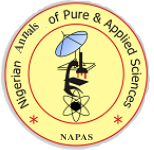Bio-Pesticidal Potentials of Elaeis Guineensis l. Kernel Oil Against Cowpea Bruchid Callosobruchus Maculatus (fab.) on Stored Cowpea Vigna Unguiculata l. (walp) Seeds
Keywords:
Perforation, mortality, seed damage, weight loss, oviposition, progenyAbstract
The cowpea bruchids Callosobruchus maculatus L is the most devastating postharvest insect pest, which attacks cowpea both in the field and store leading to significant economic losses. Laboratory
experiments were conducted to determine the insecticidal effects of Elias guineensis kernel oil at five different application rates against Callosobruchus maculatus on cowpea (Vigna unguiculata) seeds. Callosobruchus maculatus adult mortality, F1 progeny emergence, as well as the percentage (%) insect damage seeds, percentage weight loss, beetles perforation index and seed viability of cowpea seeds were assessed. The result revealed that sample treated with 0.8 ml /100g recorded the highest mortality rate of 66.67%, the least (8.33%) was recorded on the control. The oviposition was highest in the control with the mean of 2905.67 eggs while the least was on sample treated with 0.8 ml /100g with the mean of 122.33 eggs. The highest weight loss (24.27%) was recorded on the control while the least (1.00%) was recorded on sample treated with 0.8 ml /100g. The highest insect damaged seeds
(64.25%) were recorded on the control while the least (3.03%) was recorded on sample treated with 0.8 ml of oil /100g. F1 progeny emergence was highest in the control (305.00) and the least (11.00) was on sample treated with 0.8 ml/100 g. Germination was highest (100%) in the control while the least (20%) was on sample treated with 0.8 ml /100g. It was concluded that E. guineensis kernel oil is effective in reducing the attack and other negative effects of C. maculatus on stored cowpea seed and can be used as a safer alternative to toxic insecticides in the protection of cowpea seeds against this beetle.
References
Acheampong A, Ayertey JN, Eziah VY, & Ifie BE, 2019. Susceptibility of selected maize seed
genotypes to Sitophilus zeamais (Coleoptera: Curculionidae). Journal of Stored Products
Research, 81, 62-68.
Adams B, Osekre EA, and Amoah, S, 2018. Evaluation of Cowpea (Vigna unguiculata L.)
Genotypes’ Growth and Yield Performance and Resistance to the Cowpea Seed Beetle,
Callosobruchus maculatus (F.) (Coleoptera: Bruchidae). Global Journal of Agricultural
Sciences, 42, 207-209.
Adams JM, and Schulten GM, 1978. Losses caused by insects, mites and microorganisms in
KL Harris and CL Lindblad (eds). American association of cereals chemists. Post-harvest
grain loss and assessment methods. Pp.83-93.
Adenakan MO, Adejumo AO, Sodamola MO and Ajetunmobi T, 2013. Pesticidal effects of
Moringa plant parts for the control of Bruchid beetle on cowpea seeds. International
Journal of Applied Research and Technology, 2(6), 120-125.
Ahmad S, 2003. Non-food uses of palm oil and palm kernel oil. Malaysian Palm Oil Promotion
Council.
Akinniran TN, Ojedokun IK, Sanusi WA, & Ganiyu MO, 2013. Economic Analysis of Oil
Palm Production in Surulere Local Government Area of Oyo State, Nigeria. Economic
Analysis, 3, 1-13.
Ali SM, Mahgoub SM, Hamed MS, and Gharib MSA, 2004. Infestation potential of
Callosobruchus chinensis and Callosobruchus maculatus on certain broad bean seed
varieties. Egyptian Journal of Agricultural Research, 82, 1127-1135.
Aliyu M. and Ahmed BI, 2006. Comparative efficacy of different rates of groundnut oil for the
control of cowpea weevils Callosobruchus maculatus (F.) in stored cowpea, (Vigna
unguiculata (L.) Walp). Global Journal of Agricultural Sciences, 5(2), 123-126.
Beizhou S, Jie Z, Wiggins NL, Yuncong Y, Guanybo T, Xusheng S, 2012. Intercropping with
aromatic plants decrease herbivore abundance, species richness and shifts
arthropod community tropic structure. Environmental Entomology, 41, 872–879.
Bekele J, and Hassanali A, 2001. Blend effects in the toxicity of the essential oil constituents of
Ocimum kilimandscharicum and Ocimum kenyense (Labiateae) on two post-harvest
insect pests. Phytochemistry, 57(3), 385-391.
Boukar O, Fatokun C A, Huynh BL, Roberts PA, and Close TJ, 2016. Genomic tools in
cowpea breeding programs: status and perspectives. Frontiers in Plant Science, 7, 757-
Boxall RA, 1986. A critical review of the methodology for assessing farm-level grain losses
after harvest. Report of the Tropical Development and Research Institute, G191,
pp. 139.
Boyer S, Zhang H, and Lempérière G, 2012. A review of control methods and resistance
mechanisms in stored-product insects. Bulletin of entomological research, 102, 213-229.
Brooker RH, 1996. Observation on three bruchids associated with cowpea in Northern Nigeria.
Journal of Stored Products Research, 23,1-15
Deshpande VK, Makanur B, Deshpande SK., Adiger S, and Salimath PM, 2011.
Quantitative and Qualitative losses caused by Callosobruchus maculates in Cowpea
during Seed Storage. Plant Archives, 11, 723-731.
Don-Pedro KN, 1989. Mechanism of action ofsome vegetable oils against Sitophilus zeamais
Motsch. (Coleoptera: Curculionidae)on wheat. Journal of Stored Product Research, 25,
-223.
Ekeh FN, Onah IE, Atama CI, Ivoke N and Eyo JE, 2013. Effectiveness of botanical powders
against Callosobruchus maculatus (Coleoptera: Bruchidae) in some stored leguminous
grains under laboratory conditions. African Journal of Biotechnology, 12(12), 1384-1391.
Fakayode BS, Omotesho AO, and Adebayo TZ, 2014. An economic survey of cowpea (Vigna
unguiculata) storage practices in Kwara State, Nigeria. Bangladesh Journal of
Agricultural Research, 39, 47-57.
FAOSTAT, 2014. Food and Agriculture Organisation of the United Nations. Retrieved from
http://faostat3.fao.org/faostat-gateway/go/to/download/Q/QC/E on 4 May, 2014
FAOSTAT, 2016. Statistical database of the Food and Agriculture Organization of the United
Nations. http://faostat.fao.org. accessed April 2018.
Fatope MO, Mann A, and Takeda Y, 1995. Cowpea weevil bioassay: A simple prescreen for
plants with grain protectant effects. Journal of Pest Management, 41, 44–86.
Frota K, Lopes L, Silva I, and Arêas J, 2017. Nutritional quality of the protein of Vigna
unguiculata L. Walp and its protein isolate. Revista Ciência Agronômica, 48, 792-798.
Gómez, C, 2004. Cowpea: Post Harvest Operations, Post-harvest Compendium, Food and
Agriculture Organization of the United Nations (FAO). Rome, Italy.
Haghtalab N, Shayesteh N and Aramideh S, 2009. Insecticidal efficacy of castor andhazelnut
oils in stored cowpea againstCallosobruchus maculatus (F.) (Coleoptera:Bruchidae).
Journal of Biological Science,9, 175-179.
Hall AE, 2004. Breeding for adaptation to drought and heat in cowpea. European Journal of
Agronomy, 21, 447-454.
Ileke KD, Adesina JM, Nwosu LC, & Olagunju A, 2020. Perforation index assessment of
cowpea seeds against cowpea bruchid, Callosobruchus maculatus (Fabricius)[Coleoptera:
Chrysomelidae], infestation using Piper guineense. The Journal of Basic and Applied
Zoology, 81(1), 1-10.
Kang JK, Pittendrigh BR, and Onstad DW, 2013. “Insect resistance management for stored
product pests: a case study of cowpea weevil (Coleoptera: Bruchidae)”. Journal of
Economic Entomology, 106 (6), 2473-2490.
Khalid II, Elhardallou SB, and Elkhalifa EA, 2012. Composition and functional properties of
cowpea (Vigna ungiculata L. Walp) flour and protein isolates. American Journal of Food
Technology, 7, 113-122.
Muhammad A, Malgwi AM, Adamu RS, 2017. Maruca vitrata (Fabricius) [Lepidoptera:
Pyralidae] larval population dynamics as affected by intra-row spacing, sowing dates and
biopesticides on cowpea. Journal of Scientific Agriculture, 1, 352-364.
Mundua J, 2010. Estimation of Consumer Preferences for Cowpea Varieties in Kumi and Soroti
Districts, Uganda. Doctoral Dissertation, Makerere University, Uganda.125pp
Musa AK, and Adeboye AA, 2017. Susceptibility of some cowpea varieties to the seed beetle
Callosobruchus maculatus (F.) (Coleoptera: Chrysomelidae). Journal of Agricultural
Sciences, 62, 351-360.
Nana P, Nchu F, Bikomo RM, and Kutima HI, 2014. Efficacy of vegetable oils against dry
bean beetles Acanthoscelides obtectus. African Crop Science Journal, 22(3), 175-180.
National Research Council (NRC), 2006. Lost Crops of Africa’. Vegetables, Volume II: The
National Academies Press, Washington, D.C. 120pp.
Obeng-ofori D, 1995. Plant oils as grain protectants against infestations of Cryptolestes pusillus
and Rhyzopertha dominica in stored grain. Entomologia Experimentalis Applicata, 77,
-139.
Odeyemi OO, Daramola AM, 2000. Storage practices in the tropics. Volume 1: Food storage
and pest problems (1 st ed.). Dave Collins Publications, Nigeria. 253pp.
Ogendo JO, Deng AL, Belmain SR, Walker DJ, & Musandu AAO 2004. Effect of
insecticidal plant materials, Lantana camara L. and Tephrosia vogelii Hook, on the
quality parameters of stored maize grains. Journal of Food Technology in Africa, 9(1),
-35.
Raja N, Albert S, Ignacimuthu S and Dorn S, 2001. Effect of plant volatile oils in protecting
stored cowpea Vigna unguiculata (L.) Walpers against Callosobruchus maculatus (F.)
(Coleoptera: Bruchidae) infestation. Journal of Stored Products Research, 37, 127-132.
Ravinder S 2011. Biotechnological studies and control of pulse beetle C. chinensis Coleoptera;
Bruchidea) on cowpea seeds. Advances Applied Science Research, 2, 295-302
Ronner E, and Giller KE, 2013. Background information on agronomy, farming systems and
ongoing projects on grain legumes in Tanzania. N2Africa Milestones. Accessed,
/09/2020.
Roundtable on Sustainable Palm Oil, 2008. Kuala Lumpur Kepong Berhead. Aalysis and
Strategy for Sustainable Palm Oil Malaysia. Accessed, 21-07-19.
Swella GB, and Mushobozy DMK, 2007. Evaluation of the efficacy of protectants against
cowpea bruchids (Callosobruchus maculatus (F.)) on cowpea seeds (Vigna unguiculata
(L.) Walp.). Plant Protection Science-UZPI, 43, 68–72.
Tanzubil PB, 1996. Potential for Neem (Azadirachta indica A. Juss.) in Armyworm Control in
Africa. In: Neem and Environment, Singh, R.P., M.S. Chari, K. Raheja and W. Kraus
(Eds.). Vol. I. Oxford and IBH Publishing Co. Pvt. Ltd., New Delhi, India.
Tapondjoun LA, Alder A, Bonda H, and Fontem DA, 2002. Efficacy of powder and oil from
Chenpodium ambrosioides leaves as post-harvest grain protectants against six stored
products beetles. Journal of Stored Products Research, 38, 395–402.
Tarver MR, Shade RE, Shukle RH, Moar WJ, Muir WM, Murdock LM, and Pittendrigh
BR, 2007. Pyramiding of insecticidal compounds for control of the cowpea bruchid
(Callosobruchus maculatus F.). Pest management science, 63, 440-446.
Tefera T, Mugo S, Likhayo P, 2011. Effects of insect population density and storage time on
grain damage and weight loss in maize due to the maize weevil Sitophilus zeamais and
the Larger Grain Borer Prostephanus truncatus. African Journal Agricultural Research,
(10), 2249-2254.
Ugwu JA, Alabi OY, and Aluko OJ, 2021. Insecticidal activity of crude extracts of three spices
and commercial botanical pesticide on oriental fruit fly under laboratory conditions. The
Journal of Basic and Applied Zoology, 82(1), 1-7.
Umeozor OC, 2005. Effect of the infection of Callosobruchus maculatus (Fab.) on the weight
loss of stored cowpea (Vigna unguiculata (L.) Walp).
http//:www.academicjournals.org/AJB Environmental Management 9(1):169-172.
Wudil BS, Lucy E, Yusuf AU, Sule H, Abubakar M, and Fakuta NM, 2020. Bioefficacy of
Some Botanicals Against Gum Arabic Borer, Bruchus baudni Caill (Coleoptera:
Bruchidae) on Stored Senegalia senegal Seeds. Nigerian Journal of Entomology, 36: 32-
Yusuf AU, Dike MC, Adebitan SA and Ahmed BI, 2011. Comparative efficacy of seven plant
products on the cowpea bruchid, Callosobruchus maculatus development and damage.
Journal of Biopesticides, 4(1), 19-26.
Downloads
Published
How to Cite
Issue
Section
License
Copyright (c) 2023 Maza B., Abdullahi G., Medugu M. A., Aliyu A. S.

This work is licensed under a Creative Commons Attribution-ShareAlike 4.0 International License.



 Contact Us
Contact Us Editorial Team
Editorial Team Join As A Reviewer
Join As A Reviewer  Request For Print Copy
Request For Print Copy


 Cprint Publishers
Cprint Publishers